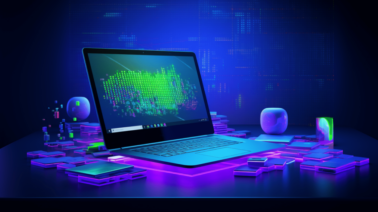As an employee, you want to be valuable for the long-term. That means constantly learning new skills. By taking the initiative, you can usher your own workplace into the 21st century, and simultaneously get the support you need to keep learning. Or, you can take your talents elsewhere!

The idea is a straightforward one. As the world outside the workplace changes, the workplace itself must change as well. Broadly speaking, workplace transformation has been happening for as long as there’s been work. But in today’s world, with the pace of technological innovation being what it is, workplace transformation has become something more specific, something more technical. We’re to the point now where workplace transformation and digital transformation are virtually synonymous concepts. Workforce transformation today means ensuring that a company is operating as close to technology’s cutting-edge as possible, in order to maximize efficiency, and enhance competitiveness. To achieve this, companies need to make sure they do two things: 1) Encourage and support the reskilling and upskilling of their own employees, and 2) Develop and implement recruiting and hiring strategies that enable them to hire the best talent equipped with the most in-demand skills.
Without a properly-skilled workforce, there can be no transformation
Alper Tekin heads up the Enterprise side of Udacity’s learning platform. In a recently-published white paper, he describes the importance of transformation in today’s workplace:
“As digital transformation disrupts the workplace, one factor more than any other will determine which companies succeed: whether your employees have the right set of skills. The reality is that business across all industries has transformed—from how food is made and delivered, to how financial transactions are conducted, to how products are manufactured and sold—resulting in fundamental changes to how we live and work. Without a properly-skilled workforce, there can be no digital transformation.”
Businesses are waking up to these truths and aggressively pursuing new strategies. According to a recent market research report published by P&S Market Research, the global workplace transformation market is expected to reach $24.1 billion by 2023. That’s an impressive degree of investment, and it’s testament to the urgency with which companies are addressing the challenges they face.
So what does this mean for you, as an employee?
Why you need to learn new skills, now
To address this question, the first thing we want to do is reframe it, so the answer becomes actionable. What does this mean for you, and what should you do about it? The answer is: commit to learning new and in-demand skills. Now. Immediately. Because this is what you want to be able to tell your employer: I’m learning valuable, in-demand skills, and you can support me, or I can take my new skills elsewhere.
If that sounds a bit too antagonistic, rest assured, it doesn’t have to be that way. In fact, employees taking it upon themselves to learn new skills is often the best thing that can happen to a company, because it’s often the tipping point that marks the beginning of real company-wide change.
The important thing for you to know, as an employee, is that you need to learn new skills. No matter how accomplished you are, technology’s ever-accelerating impact means your skills have a shelf life, and if you want to stay valuable, you need to stay up-to-date. It’s in your company’s interest to support you in that process, so the sooner you make that clear to them, the better.
Take the initiative
We recently profiled a Udacity graduate with twenty years of software engineering experience who took it upon himself to master new machine learning skills. Here’s what happened after Antal Berenyi graduated from our Machine Learning Engineer Nanodegree program:
“I approached my boss and said I was interested in taking on projects that involved machine learning. I sent her a list of the courses I’d taken in the Nanodegree program, as well as some other data science courses. I think she was impressed with my eagerness and, combined with my previous experience, it didn’t take much convincing. I already had knowledge of the pharmaceutical domain, software development skills, and a familiarity with data. Then the Nanodegree program meant I added critical machine learning skills to my toolset.”
By taking the initiative, he’s not only landed himself a new data scientist role, he helped his company accelerate its embrace of an incredible new technology.
Automation and the modern workplace
Employers are becoming very aware of the importance of empowering their employees. A recent article from CMSWire entitled The Missing Link for Digital Transformation Success? People is but one example of the message employers are getting from all sides:
“As automation eats up the easy, repetitive labor, human work will continue to become less routine, requiring people (and the technology supporting them) to be highly dynamic and agile. Be sure to give your employees the trust and ability to own and tweak their workflows, make decisions and even challenge old workplace policies.”
This matter of automation is a particularly pressing issue, for both employers and employees. On the employer side, businesses are feeling the heat when it comes to implementing AI and machine learning-powered strategies. They know they urgently need to get up to speed, but they don’t necessarily know how to do it, and they often don’t have the talent to achieve the transformation. Here’s Alper Tekin again:
“The changes caused by automation and AI have come on so fast that most employers have not had time to begin investing in the skills of their workers. Similar to the internet and mobile waves, organizations are getting caught off guard.”
A recent Investor’s Business Daily article, reporting on announcements made by Morgan Stanley, confirms the urgency:
“Artificial intelligence and machine learning have become ‘a top 10 spending priority’ for corporate chief information officers, Morgan Stanley analyst Katy Huberty said in a note to clients Friday.”
Challenges and opportunities for employees
This state of affairs presents two challenges to employees, both of which can be seen simultaneously as opportunities.
First, if your company is trying to pursue the embrace of AI, machine learning, and automation, then you can assume they need people who can help them achieve that goal. If you don’t have those skills, then it isn’t you they’re looking for. That’s a problem. But it’s also an opportunity. You can learn the skills, and become valuable all over again. You can help initiate positive workforce transformation.
Second, if your company is pursuing AI, machine learning, and automation strategies, then your job is likely to change. Much of what you currently do could be automated. That’s a problem. But it’s also an opportunity. In fact, it’s two opportunities. You can learn the skills that better prepare you for working alongside automation solutions (e.g. robots), and you can double-down on those skills that can’t be so easily automated.
Workforce transformation: It’s not what, it’s how
Ultimately, the questions aren’t about what is going to change—they’re about how change is going to happen. Workforce transformation is a given; it simply has to happen for companies to stay viable, competitive, and successful. And employees need to continually learn new skills; that’s a given as well. Companies need you to be up-to-date, and you need you to be up-to-date.
So as an employee, the only question that really matters is, how are you going to keep learning? Ideally, it will be with the support of your current company. But if they’re not providing what you need, you have options. You can do like Antal Berenyi did, and take it upon yourself to learn new skills. Or maybe better yet, you can introduce your company to Alper and Udacity’s Enterprise team. They’re more than happy to help!



